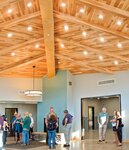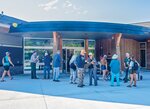Support the Timberjay by making a donation.
New Voyageurs visitor center makes its debut
Opens to the public next spring
CRANE LAKE- The National Night Out celebration in Crane Lake on Aug. 6 was also a coming out party of sorts for the new Crane Lake Visitor Center, which held an open house to let people tour the newest gateway to Voyageurs National Park.
Park records indicate that a multi-agency visitor center for Crane Lake had been in the park’s plans at least since 2002, when then Superintendent Barbara West included it in a visitor use and facilities plan. But the project languished, and it wasn’t until years later when the Crane Lake community took the bull by the horns to make the center a reality.
“This whole process started back in 2018– that was the year the town got serious about this land because it had sat empty for about 20 years,” said Gretchen Janssen, who’s been involved with the project as a member of the town visitor center and campground committee. “We hired a lobbyist and made a plan. We had a lot of community involvement, a lot of meetings and design workshops, and presented it to the state Legislature and were awarded grant money.”
Funding for the center and the adjoining campground came from the Legislative-Citizen Commission on Minnesota Resources, the Department of Iron Range Resources and Rehabilitation, and the Department of Natural Resources, Janssen said.
“Voyageurs National Park has been a great partner,” she said. “They’ve always wanted a visitor center in Crane Lake, but because they didn’t own land in Crane Lake it was impossible for them, so this is a real win-win. The town owns the building, and we’ll have about 70 percent of it leased out to Voyageurs National Park, and the rest will be town offices.”
VNP Superintendent Bob DeGross said that he’s excited to see the center finally coming together.
“Since 2017 we’ve been talking with the community on how to get this done, so it’s really exciting to see it actually getting close to operational, which will hopefully be next spring or summer,” he said. “The work that the community leadership put into the creative way of finding funding and support to get this done is just outstanding.”
Up until now, visitors accessing VNP through Crane Lake had to depend on the local business community for information about the park, and DeGross said their assistance has been invaluable.
“We really appreciate the support and partnership that the local community businesses gave to visitors,” he said. “But now that we have the space, we’ll be able to be here and provide that information and the resorts can concentrate on their guests, but we’ll all do it in partnership.”
VNP will occupy the welcome/exhibit area and an auditorium for informational presentations, as well as two of the four offices in the building, DeGross said.
“A lot of what we are going to be doing is focusing on orientation, letting people know where they’re at in the grander picture of the park,” he said. “One of the unique things about Crane Lake is that it is not only a gateway to Voyageurs National Park, it’s also the gateway to the western entrance of the Boundary Waters, and to Quetico Provincial Park up in Canada as well. So, it’s sort of uniquely situated in that regard. We have four gateway communities, and the way people tend to visit the park is to go to one gateway community to get their information and then go into the park, so it’s important to have that orientation and welcome opportunity for the different visitors that are coming in.”
Voyageurs Conservancy, the park’s nonprofit partner that supports educational, recreational, and conservation projects, is engaged with helping to develop the exhibits in the visitor center, and they recently contracted with Sarah Zwier, a St. Paul-based designer who specializes in exhibit design, to spearhead the Crane Lake development. Zwier’s past clients have included the Minnesota Historical Society, Arizona State University, the Children’s Museum of Southern Minnesota, the Jay C. Hormel Nature Center, the Minnesota State Fair, and the Children’s Discovery Museum of Maine.
“I’m working on the design and development phase of the exhibit design where we generate research and gather stories about the area, about the park,” Zwier said. “We start to figure out what the big themes are, what makes this place special, and from there we start to look at the space. We look at different ways we can engage visitors, whether that be graphic panels, large murals, media pieces, or video interactives. We’re really trying to find a variety of ways to engage visitors and help them learn more. Crane Lake is a really special place, and there’s a rich history of stories to be told, voyageurs, settlers, the fur trade, the Ojibwe. There’s a lot of really great personal stories that we can tell here. So, I think it’s just a really exciting project to be part of.”
Two themes that have emerged in the process so far are the historical Indigenous culture of the park and the night skies, as VNP is an International Dark Sky Park. Zwier sees possibilities for integrating those themes in the exhibits.
“There’s some really interesting resources that we’ve found that talk about the Ojibwe knowledge of the constellations and how they tracked cycles and seasons and everything, and because dark sky and constellations are so prominent here, we’re really excited to try to engage that as another layer of information,” she said.
Janssen said that the visitor center will likely open Memorial Day weekend next year.
“It’s going to take us the winter to get the finishing touches on the building and get the exhibits complete,” she said. The center will operate primarily in the summer, but Janssen said that the town could open the center on a limited basis in the winter if there are a lot of snowmobilers in town.
DeGross said that ideally the center will be open from Memorial Day to Labor Day, and that it will initially be staffed primarily by volunteers, with support from VNP employees.
“Eventually, I’m hoping that we can get a committed staff person that would be able to work from this space,” he said. “We do have a law enforcement ranger that works out of Crane Lake, and he will be housed in this building.”
“It’s just exciting to see something that has taken so long to come to fruition through all the partnerships it required to get it done actually getting implemented and moving toward operation,” DeGross said.









